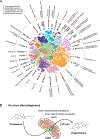Single cell resolution of neurosteroidogenesis in the murine brain: de novo biosynthesis
- PMID: 40261711
- PMCID: PMC12377410
- DOI: 10.1530/JOE-24-0318
Single cell resolution of neurosteroidogenesis in the murine brain: de novo biosynthesis
Abstract
Neurosteroids synthesized within the central nervous system play essential roles in modulating neurotransmission, providing neuroprotection, regulating immune responses, influencing behavior and cognition and mediating stress physiology. Despite their broad significance, the specific brain cell types capable of de novo steroid synthesis from cholesterol remain poorly defined. In this study, we analyzed single-cell transcriptomic data to map steroidogenic gene expression across cell populations in the murine brain, focusing on the de novo production of the neurosteroid pregnenolone. Our findings reveal that de novo steroidogenesis, as marked by Cyp11a1 expression, is predominantly confined to specific neuronal subtypes, particularly glutamatergic neurons of the intra- and extra-telencephalic regions and the corticothalamic layer. In contrast, Star expression, which is essential for mitochondrial cholesterol import, was more broadly distributed, occurring in both neuronal and non-neuronal cells (including oligodendrocytes, astrocytes, immune cells and vascular cells). In these non-neuronal populations, Star was notably co-expressed with mitochondrial Cyp27a1, indicative of bile acid synthesis rather than neurosteroidogenesis. This distinction highlights that Star expression alone is not a reliable marker of de novo neurosteroidogenic capacity in the brain, as its functional significance depends on the broader enzymatic context in which it occurs. The resulting single-cell map of de novo neurosteroid biosynthetic capacity across brain regions, including modest sex-associated differences, provides a foundational framework for understanding neurosteroid signaling in distinct cell types and its relevance to brain physiology and pathophysiology.
Keywords: astrocyte; bile; microglia; neuron; oligodendrocyte; pregnenolone.
Conflict of interest statement
Declaration of interest
The authors declare that there is no conflict of interest that could be perceived as prejudicing the impartiality of the research reported.
Figures





Similar articles
-
Single cell resolution of neurosteroidogenesis in the murine brain: intermediary biosynthesis.J Endocrinol. 2025 May 7;265(3):e240333. doi: 10.1530/JOE-24-0333. Print 2025 Jun 1. J Endocrinol. 2025. PMID: 40261706 Free PMC article.
-
Prescription of Controlled Substances: Benefits and Risks.2025 Jul 6. In: StatPearls [Internet]. Treasure Island (FL): StatPearls Publishing; 2025 Jan–. 2025 Jul 6. In: StatPearls [Internet]. Treasure Island (FL): StatPearls Publishing; 2025 Jan–. PMID: 30726003 Free Books & Documents.
-
Expression of pregnenolone-synthesizing enzymes CYP11A1 and CYP1B1 in the human, rat, and mouse brain.Steroids. 2024 Dec;212:109521. doi: 10.1016/j.steroids.2024.109521. Epub 2024 Oct 10. Steroids. 2024. PMID: 39395524
-
Gender differences in the context of interventions for improving health literacy in migrants: a qualitative evidence synthesis.Cochrane Database Syst Rev. 2024 Dec 12;12(12):CD013302. doi: 10.1002/14651858.CD013302.pub2. Cochrane Database Syst Rev. 2024. PMID: 39665382
-
Home treatment for mental health problems: a systematic review.Health Technol Assess. 2001;5(15):1-139. doi: 10.3310/hta5150. Health Technol Assess. 2001. PMID: 11532236
Cited by
-
Single cell resolution of neurosteroidogenesis in the murine brain: intermediary biosynthesis.J Endocrinol. 2025 May 7;265(3):e240333. doi: 10.1530/JOE-24-0333. Print 2025 Jun 1. J Endocrinol. 2025. PMID: 40261706 Free PMC article.
References
-
- Banati RB, Middleton RJ, Chan R, Hatty CR, Wai-Ying Kam W, Quin C, Graeber MB, Parmar A, Zahra D, Callaghan P, Fok S, Howell NR, Gregoire M, Szabo A, Pham T, Davis E, Liu GJ. 2014. Positron emission tomography and functional characterization of a complete PBR/TSPO knockout. Nature Communications 5. (doi: 10.1038/ncomms6452) - DOI - PMC - PubMed
-
- Baulieu E-E 1981. Steroid hormones in the brain: Several mechanisms? In Steroid Hormone Regulation of the Brain, pp 3–14. Eds Fuxe K, Gustafsson J-Å & Wetterberg L. Pergamon. (doi: 10.1016/B978-0-08-026864-4.50007-4) - DOI
MeSH terms
Substances
Grants and funding
LinkOut - more resources
Full Text Sources

